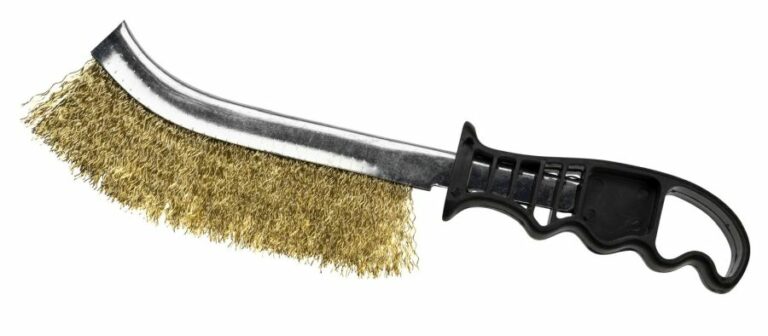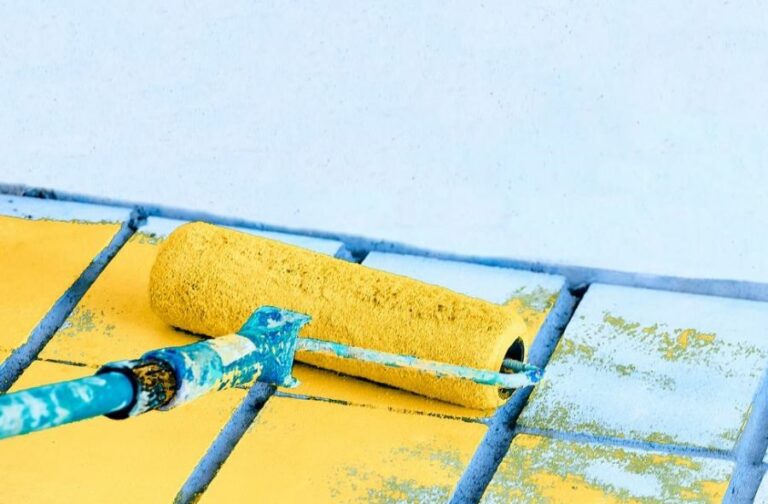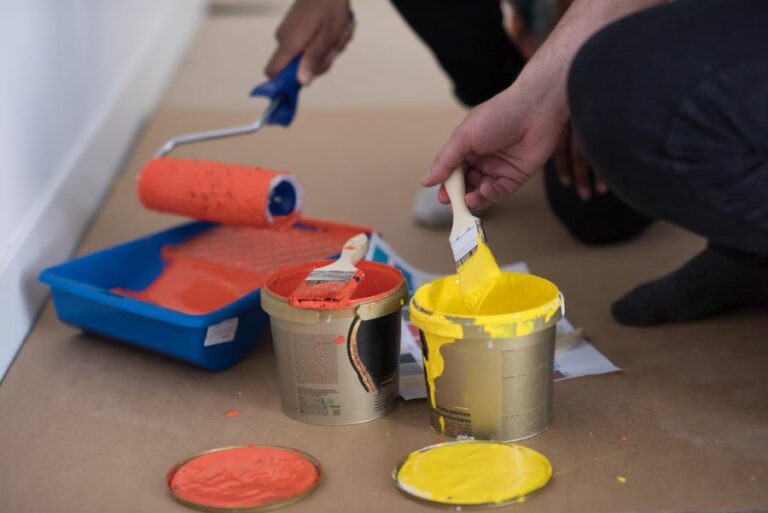Pro Paint Application Sanding Tricks. What Pros Say
As a professional painter, I’ve learned that the key to a smooth and flawless paint job lies in the preparation, specifically – sanding. Today, I’m excited to share my pro paint application sanding tricks that will elevate the quality of your paint job, leaving your surfaces looking professionally done. With the help of these techniques, you will not only save time and effort, but you’ll also achieve top-notch results that’ll make your painting projects stand out.
Pro paint application: sanding tricks:
To achieve a professional paint application, use appropriate sandpaper grit and materials and techniques like cross-sanding, wet sanding, using a sanding block, and paying attention to edges and corners. Proper surface preparation and dust removal are essential for a smooth, durable paint finish.

Ready to take your painting skills to the next level? Our Pro Paint Application guide will reveal top sanding tricks and techniques to achieve a flawless finish. Keep reading for expert advice and exclusive tips to elevate your paint game. Don’t miss out!
Contents
- 1 Professional Paint Application: Sanding Techniques
- 2 Accelerating Sanding Process: Top Methods
- 3 Expert Sanding Hints and Strategies
- 4 Optimal Techniques for Sanding Paint Surfaces
- 5 Ideal Smoothness Level for Pre-Painting Sanding
Professional Paint Application: Sanding Techniques
• Importance of Proper Sanding in Paint Projects
To achieve a professional finish on any paint project, whether it’s a house exterior, a piece of furniture or any other surface, proper sanding is the key. Sanding helps in removing old paint, leveling the surface, and creating a better surface for the new paint to adhere to.
• Types of Sandpaper and Their Uses
Before diving into the variety of sanding tricks, it’s essential to understand the different types of sandpaper available and their best uses. Sandpaper comes in a variety of grits, ranging from 40 to 2000.
The lower the grit number, the coarser the sandpaper, making it more effective in removing old paint and leveling the surface. The higher the grit number, the finer the sandpaper, allowing for a smoother finish.
- Coarse sandpaper (40-60 grit): Ideal for removing old paint or varnish from surfaces.
- Medium sandpaper (80-120 grit): Suitable for smoothing rough surfaces and removing smaller imperfections.
- Fine sandpaper (150-180 grit): Used for final surface preparation before applying paint or primer.
- Superfine sandpaper (2000 grit): Perfect for creating a very smooth finish, often used for wet-sanding.
In addition to different grits, sandpapers are also available in different materials, such as aluminum oxide, silicon carbide, and garnet. Choose the appropriate sandpaper for your specific application to get the best results.
• Sanding Tricks and Techniques for a Professional Finish
– Cross-Sanding Technique
Cross-sanding is a technique that involves sanding in alternating diagonal directions. This method allows for smoother and more even leveling of the surface. Start by sanding diagonally from one corner to the other, then switch directions and sand diagonally in the opposite direction.
This technique will help you avoid creating uneven surfaces while preparing the surface for painting.
– Wet Sanding
Wet sanding is an advanced technique that can produce incredibly smooth surfaces. It involves using very fine grit sandpaper, typically 2000 grit, and wetting the surface before sanding. This method creates a slurry, reducing friction and allowing the sandpaper to glide smoothly across the surface.
Wet sanding is particularly useful when working with automotive paint projects or creating a glass-like finish. Make sure to use proper safety equipment, such as gloves and a respirator, while wet sanding.
– Using a Sanding Block
A sanding block helps to distribute pressure evenly across the surface, making it easier to achieve a smooth, level finish. A sanding block can be made from a scrap piece of wood or purchased at any hardware store.
Simply wrap your sandpaper around the block and start sanding. A sanding block can prevent your fingers from creating divots or pressure points in the surface, resulting in an even finish.
– Sanding Edges and Corners
For a professional finish, it’s essential to pay attention to the edges and corners of the surfaces you’re painting. These areas can be challenging to sand properly, but using the right technique can make a big difference.
For edges, fold a piece of sandpaper and run it along the edge to avoid scratching adjacent surfaces. For corners, start with a coarse grit sandpaper to remove excess material, then switch to a finer grit to smooth the surface.
– Vacuuming and Tack Cloth
After sanding, it’s crucial to remove any remaining dust or debris from the surface before applying paint or primer. Use a vacuum cleaner with a brush attachment or an air compressor to remove dust from the surface. Then, wipe the surface with a tack cloth to pick up any remaining fine particles.
Following this process can ensure a smooth and clean surface for paint application.
• Final Thoughts
Proper sanding is essential for achieving a professional paint application and understanding the types of sandpaper, using the right techniques, and taking the time to prep the surface before painting results in a much better paint job that will stand the test of time.
By following the sanding tricks and techniques mentioned in this article, you’re on your way to a pro-level paint finish.
Accelerating Sanding Process: Top Methods
Sanding is a crucial step in woodworking, painting, and other finishing tasks. However, it can be time-consuming and labor-intensive. Luckily, there are techniques and tools that can help make the sanding process more efficient and much faster.
• Using the Right Tools
One of the most important factors in speeding up the sanding process is using the right tools. Investing in quality sanding tools can save you time and effort in the long run.
– Power Sanders
Power sanders, such as orbital and random orbit sanders, can significantly speed up large-scale sanding projects. These electric tools eliminate the need for manual labor, saving time and reducing fatigue.
Be sure to choose a sander with variable speed settings to control the aggressiveness of the sanding action and reduce the risk of over-sanding.
– Hand Sanding Blocks
For smaller projects or tricky areas where power sanders are not suitable, using a hand sanding block can improve your sanding speed. Hand sanding blocks provide better control and help maintain consistent pressure on the surface, reducing the time and effort needed to achieve a smooth finish.
– High-Quality Sandpaper
Choosing the right sandpaper for your project can also have a significant impact on the time it takes to complete sanding. High-quality sandpaper not only lasts longer but also removes material more quickly and efficiently, reducing the amount of time needed for each grit.
Look for sandpaper with a high grit count and consistent abrasive particles, such as aluminum oxide or silicon carbide.
• Perfecting Your Technique
In addition to using the correct tools, improving your sanding technique can also help speed up the process while ensuring a high-quality finish.
– Start with Coarser Grits
By starting with a coarser grit, you’ll be able to remove material faster and get the project to the desired shape more easily. As the surface smoothens, gradually work your way through finer grits to achieve the desired finish.
Skipping grits or jumping to a finer grit too soon can actually end up taking more time, as you’ll need to spend more time sanding to remove the deep scratches left by the coarser grits.
– Keep the Sandpaper Clean
As you sand, the abrasives on your sandpaper can become clogged with dust and debris, leading to less efficient sanding. Regularly clean your sandpaper by tapping or brushing it on a hard surface to remove build-up. This helps maintain the efficiency of the sandpaper, allowing it to work faster and last longer.
– Use Even Pressure
Applying consistent pressure while sanding is crucial for an even finish and a faster sanding process. Too much pressure can lead to gouging or uneven sanding, while too little pressure can slow down the process. Use firm, steady pressure and let the sandpaper do the work.
– Utilize Proper Direction
When using power sanders, always sand in the direction of the wood grain. For hand sanding, use diagonal strokes and then sand with the grain for the final pass. This technique helps minimize scratches and produces a smoother surface more quickly.
• Keep Your Work Area Organized
A well-organized workspace can also improve your sanding efficiency. Proper organization ensures that you have easy access to the tools and materials you need, reducing downtime and frustration.
- Keep sandpaper sorted by grit type and organized in labeled containers.
- Store hand sanding blocks, power sanders, and other tools in designated areas within reach.
- Maintain a clean and clutter-free workspace to help you focus on the task at hand.
• Learn from the Experts
Taking the time to learn from experienced woodworkers, painters, or other professionals in your field can help improve your sanding skills and efficiency.
Attend workshops, watch instructional videos, or read articles and books from reputable sources to stay updated on the latest tips and techniques in your trade.
One great resource for learning about woodworking and sanding techniques is the Woodworker’s Guild of America website, which offers video tutorials, articles, and other valuable resources.
• Conclusion
In summary, the best way to speed up the sanding process is by investing in the right tools, perfecting your technique, and keeping your workspace organized.
By taking the time to implement these strategies and continuously learning from the experts in your field, you can achieve a faster, more efficient sanding process without compromising the quality of your finished project.
Step | Description |
|---|---|
1 | Use the right type of sandpaper for your project. |
2 | Start with a coarse-grit sandpaper to quickly remove surface material. |
3 | Progress to finer grits of sandpaper to achieve a smoother finish. |
4 | Use a power sander, such as an orbital or belt sander, to save time and effort compared to hand-sanding. |
5 | Apply even pressure and maintain a steady speed when sanding to avoid uneven removal of material. |
6 | Keep the sandpaper clean and replace it when it becomes worn or clogged to maintain its effectiveness. |
7 | Use a sanding block, especially when hand-sanding, to ensure even pressure and prevent uneven sanding. |
Expert Sanding Hints and Strategies
Sanding is an essential process when working with wood, metal or other materials. A well-executed sanding job can greatly improve the appearance and function of your projects.
• Choosing the Right Sandpaper
Selecting the appropriate sandpaper for your project is crucial for achieving the desired outcome. Here are some recommendations on how to choose the right sandpaper:
- Grit: The grit number indicates the roughness of the sandpaper. Lower grit numbers represent coarser sandpapers, while higher grit numbers are finer. When sanding, start with a lower grit sandpaper and progressively work your way up to a higher grit. This process helps to remove material faster and results in a smoother finish.
- Material: Sandpapers are available in a variety of materials, each designed for specific tasks. Aluminum oxide sandpapers are versatile and suitable for most woodworking and metalworking projects. Silicon carbide sandpapers are ideal for wet sanding and provide a finer finish on metal and plastic surfaces. Ceramic sandpapers are incredibly durable and are recommended for aggressive sanding on wood.
- Backing: The backing of sandpaper affects its flexibility and durability. Cloth-backed sandpapers are more flexible and durable compared to paper-backed sandpapers, making them suitable for sanding curved or irregular surfaces.
• Proper Sanding Techniques
Implementing proper sanding techniques can significantly improve the quality of your work. Here are some tips on how to approach sanding:
– Hand Sanding
Hand sanding is suitable for smaller projects and intricate details. The following tips can help you achieve the best results:
- Sanding direction: When sanding wood, always sand in the direction of the grain. This prevents scratches and maintains the natural appearance of the material.
- Sanding blocks: Using a sanding block can help you maintain even pressure and coverage, resulting in a more uniform surface. You can purchase a sanding block or create one by wrapping sandpaper around a flat, rigid object.
- Backing off pressure: As you reach your desired smoothness, reduce the pressure you apply to the sandpaper. This will help create a finer finish.
– Power Sanding
Power sanding is efficient and effective for larger projects. When using power sanders, keep these tips in mind:
- Random orbital sanders: These sanders are versatile and excellent for general-purpose sanding. They create a smooth, scratch-free finish and are suitable for various materials. Always start with coarse-grit sandpaper and progress to finer grits.
- Belt sanders: Belt sanders are best for aggressively removing material, such as leveling surfaces or removing paint. Use caution when using a belt sander, as it can quickly damage your project if you apply too much pressure or use the wrong grit.
- Workbench setup: When using a power sander, ensure your workpiece is securely clamped to a stable work surface. This helps prevent accidents and provides a safer work environment.
• Sanding Safety Tips
Safety is paramount when working with any tools, and sanding is no exception. Follow these guidelines to ensure a safe sanding experience:
- Eye protection: Wear safety goggles to protect your eyes from dust and debris.
- Dust masks: A proper respiratory dust mask prevents the inhalation of harmful particles. N95 masks are highly recommended for filtering out dust and other small particles.
- Hearing protection: Power sanders can produce high noise levels, so wearing ear protection is essential.
- Avoid loose clothing and jewelry: Loose items can become entangled in power sanders, increasing the risk of injury.
• Clean Up and Finishing Touches
Proper clean-up and finishing touches are crucial to a successful sanding job. Consider the following tips:
- Vacuum: Use a vacuum to remove dust and debris from your work area and project. This helps ensure a clean surface for applying finishes or paint.
- Tack cloth: After vacuuming, use a tack cloth to remove any remaining dust. This helps prevent contaminants from becoming trapped under a finish.
- Progressive sanding: When applying finishes, it is recommended to sand between coats. This helps promote adhesion and creates a smoother final finish. Use fine or extra-fine grit sandpaper for optimal results.
By incorporating these tips and tricks into your sanding projects, you can improve your results and create professional, high-quality finishes. Remember, practice makes perfect, so don’t be afraid to experiment and refine your sanding techniques.
Tip/Trick | Description |
|---|---|
Choose the right grit | Start with a coarser grit for rough surfaces, and progress to finer grits for a smooth finish. |
Use proper technique | Sand with the grain, applying even pressure and moving in a consistent direction. |
Keep sandpaper clean | Regularly clean sandpaper by tapping it or using a brush to remove built-up particles. |
Use a sanding block | A sanding block ensures even pressure over the surface, and reduces hand fatigue. |
Use a damp cloth to check progress | Wipe the surface with a damp cloth to remove dust and reveal remaining imperfections. |
Choose the right sanding tool | Use electric sanders for large surfaces and manual sanding for smaller or detailed areas. |
Protect your health | Wear a mask and goggles to protect your lungs and eyes from dust, and ensure proper ventilation. |
Maintain your sanding equipment | Regularly inspect and replace worn-out sandpaper and parts on electric sanders. |
Finish with fine grit | Finish sanding with a fine grit sandpaper for the smoothest surface before painting or staining. |
Optimal Techniques for Sanding Paint Surfaces
Sanding paint is a crucial stage in any painting project, be it furniture restoration or repainting walls. While it may seem like a mundane task, the right technique yields impressive results.
• Choosing the Right Sandpaper
There are key factors to consider when selecting sandpaper for your project:
- Grit: The number of abrasive particles per inch determines the grit size. The higher the number, the finer the grit. Finer grits result in a smoother finish, while lower grits remove paint faster.
- Material: Synthetic or natural abrasives are bonded to paper or fabric backing. Aluminum oxide, silicon carbide, and garnet are popular choices for sanding paint.
- Type: Sandpaper comes in sheets, rolls, belts, and discs. Choose the one that fits your sanding tool or method.
– Recommended Grit Progression
To achieve the best results, start with a coarser grit and work your way towards finer grits.
- 80 Grit: This removes thick layers of paint quickly. Use caution, as it can leave deep scratches that require further sanding.
- 120 Grit: A medium-coarse grit that removes paint at a moderate pace with fewer scratches.
- 180 Grit: This fine grit creates a smooth, paint-ready surface.
• Choosing the Right Sanding Method
There are several sanding methods to choose from. Your choice depends on the size and shape of the project, along with its complexity.
– Hand Sanding
Ideal for small or delicate areas, hand-sanding involves wrapping a sandpaper sheet around a sanding block or using your hand as a backer. This method offers the most control but can be labor-intensive and time-consuming. For the best results, sand in a circular motion or with the grain of the wood.
– Orbital Sander
An orbital sander is a powered hand tool that simultaneously spins and oscillates the sandpaper. It provides an even and uniform finish, making it suitable for flat surfaces. Be cautious not to press down too hard or let the sander rest in one spot, as this may cause swirl marks.
– Random Orbital Sander
Featuring a random orbital motion, this power tool prevents forming distinct patterns on the surface. It’s useful for both small and large projects and is a popular choice for sanding paint.
– Detail Sander
Also known as a “mouse” sander, this tool is designed for intricate areas where an orbital or random orbital sander doesn’t fit. Its compact size and precise operation make it perfect for detailed work.
• Essential Sanding Techniques and Tips
Follow these tips to ensure a hassle-free sanding process:
- Wear Protective Gear: Always wear a dust mask, safety goggles, and gloves when sanding paint. This prevents inhaling dust particles and keeps your hands safe from abrasion.
- Use Proper Lighting: Good lighting helps you identify painted areas that need further sanding, ensuring a uniform finish.
- Clean the Surface: Remove dust with a cloth or vacuum cleaner between each grit change to prevent re-scratching the surface.
- Apply Even Pressure: Applying consistent and even pressure ensures a uniform finish. Exerting too much force can damage the wood or leave marks on the surface.
- Inspect the Surface: Regularly check your progress by running your hand over the surface. A smooth, even texture indicates the paint has been sufficiently sanded.
• Wet Sanding for a Flawless Finish
Wet sanding is particularly useful when working with automotive paint or other high-gloss finishes. It prevents dust accumulation, reduces sanding marks, and produces a glass-like finish.
To wet sand, simply dip high-quality waterproof sandpaper (such as silicon carbide) in water and begin sanding. Frequently rinse the sandpaper to remove paint particles and maintain a consistent finish.
For more information on wet sanding, check out this informative guide from Ohio State University.
• Final Thoughts
Effective sanding is the key to professional-looking paint jobs. By choosing the right sandpaper, employing the appropriate techniques, and following essential guidelines, you’ll achieve a paint-ready surface that showcases your hard work.
Remember, attention to detail and patience always yield remarkable results.
Ideal Smoothness Level for Pre-Painting Sanding
Sanding is a crucial step in the painting process, as it directly affects the final result. The smoother the surface, the better your paint will adhere and the more professional your painting job will appear.
• Importance of Sanding
Sanding creates a rough surface that provides better adhesion for the paint. It also helps to remove any imperfections or bumps, ensuring a smooth and even paint finish. Considering the time and effort you invest in a painting project, properly preparing the surface will ultimately save you from distress and disappointment.
• Factors that Determine the Desired Smoothness
– Surface Material
The type of surface being painted influences the smoothness required. For example:
- Wood: For bare wood, sanding is necessary to remove imperfections, raised grain, and existing paint or stain. A smoother finish is desirable on trim, doors, and furniture, where a glossy paint finish is typically used, whereas a rougher surface is suitable on siding and decks that will be exposed to the elements.
- Drywall: Since drywall is much softer than wood, sanding is needed to create a smooth, seamless surface between the joints and remove any surface imperfections.
- Metal: Sanding is essential to remove any rust, scale, or existing paint on metal surfaces, providing a suitable foundation for primer and paint.
– Type of Paint and Finish
The choice of paint type and finish directly affects the level of smoothness necessary:
- Glossy Paints: Higher-gloss finishes, such as semi-gloss and high-gloss paints, magnify surface imperfections. To achieve a flawless finish, it’s essential to thoroughly sand the surface to a smoother texture.
- Matte Paints: Matte and flat paints are more forgiving in terms of surface imperfections, requiring less-extensive sanding. However, it’s still important to ensure a uniformly sanded surface for proper paint adhesion and an even finish.
• Recommended Sandpaper Grits
Depending on the surface material and the paint type, different sandpaper grits are recommended for achieving the desired smoothness:
- Coarse Grit (40-60): Ideal for removing heavy paint or varnish, as well as smoothing rough surfaces like sawn wood or weathered outdoor surfaces.
- Medium Grit (80-120): Suitable for evening out surface imperfections on wood, drywall, or metal before applying primer or paint.
- Fine Grit (150-180): Perfect for final sanding before applying paint, as it smooths surfaces and prepares them for proper adhesion.
- Very Fine Grit (220-240): Recommended for sanding between coats of paint, ensuring a flawless finish.
• Sanding Techniques for Optimal Smoothness
To achieve the best results, follow these sanding techniques:
- Start with the right grit: Begin with the coarsest grit necessary to remove surface imperfections and gradually progress to finer grits for a smoother finish.
- Sanding direction: Sand in the direction of the surface’s grain, especially when working with wood. This technique ensures that any scratches created by sanding will blend in with the natural texture.
- Keep the sandpaper clean: Regularly clean sandpaper to prevent clogging, which can lead to an uneven surface texture.
- Inspect the surface: Continually check the surface as you sand to ensure the desired level of smoothness.
- Use a sanding block: Using a sanding block with your sandpaper keeps the pressure even and ensures a smoother, more consistent finish.
• Final Aspects to Consider
Remember that the goal is to create a surface that allows proper adhesion and an attractive, durable paint finish. Consider investing in good-quality paint, which often contains additives for better adhesion and leveling, compensating for minor imperfections in your sanding job.
In conclusion, the smoothness required before painting varies depending on the surface material, type of paint, and desired finish.
Use the recommendations provided in this article alongside relevant resources, such as the Paint Quality Institute, to ensure that you achieve the optimal sanding level for a perfect paint job. Good luck with your painting project!







